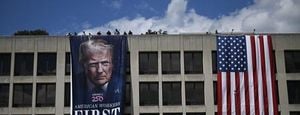On September 2, 1945, the world watched as the Second World War officially drew to a close. The scene aboard the USS Missouri in Tokyo Bay was nothing short of historic: hundreds of military officials, dignitaries, and journalists crowded the deck to witness Japan’s formal surrender to the Allied powers. Yet, amid the gravity of the occasion and the parade of legendary figures, it was a relatively unknown Canadian officer who would, quite unintentionally, find himself at the center of a diplomatic hiccup that almost overshadowed the proceedings.
Col. Lawrence Cosgrave, Canada’s defense attaché to Australia at the time, was the highest-ranking Canadian military officer able to reach the ceremony in time, according to CBC’s defense and foreign policy correspondent Murray Brewster. Cosgrave’s presence was essential for Canada, but it was not his military prowess or diplomatic experience that would be remembered most vividly from that day. Instead, it was a simple, human mistake—a misplaced signature—that nearly disrupted one of the most significant moments of the 20th century.
The ceremony itself was steeped in symbolism and tension. Allied and Japanese representatives stood on opposite sides of a table hastily brought from the battleship’s mess hall, upon which two copies of the instrument of surrender awaited signatures. One copy was destined for the Japanese, the other for the Allies. As the Japanese delegation, led by Foreign Minister Namoru Shigemitsu, solemnly signed the document, the world held its breath. The Allied representatives followed suit, each taking their turn to add their name to the pages that would end years of global conflict.
When Cosgrave’s turn arrived, the atmosphere was charged. He was surrounded by towering figures of history—men whose names would be etched into textbooks and memorials. Brewster told NPR, “I’m pretty sure that he was in awe of standing among so many high-ranking officers. I mean, ones whose names go down in history.” Perhaps it was the pressure, or perhaps a trick of vision—Cosgrave had lost an eye in the First World War—but as he sat down to sign, he inadvertently placed his signature on the wrong line.
What might have been a minor clerical error in any other setting now threatened to derail the entire ceremony. The Japanese delegation, upon noticing the misalignment of signatures, voiced their concern to General Douglas MacArthur’s chief of staff. They suggested, at least initially, that they would not accept the document as valid if the signatures were not all in their proper places. In that instant, the conclusion of the war itself appeared to hang in the balance, all because of a misplaced name.
But cooler heads prevailed. Someone among the Allied officers devised a quick fix, and after some negotiation, the Japanese relented. The document was accepted, and the war was formally declared over. Yet, as The New York Times would later note in Cosgrave’s 1970 obituary, he “unintentionally delayed the conclusion of the armistice.” The incident, brief as it was, became an indelible part of the day’s lore.
For Cosgrave, the misplaced signature became a defining moment—one that, according to Brewster’s research for Legion Magazine, overshadowed a life of service and sacrifice. Cosgrave was no stranger to the horrors of war. He had entered World War I, as Brewster put it, “full of patriotic zeal,” only to be deeply traumatized by the carnage he witnessed in some of its bloodiest battles. The experience left him physically marked as well; he lost an eye, a wound that would follow him for the rest of his days.
After the First World War, Cosgrave transitioned into diplomacy, serving in East Asia and traveling extensively throughout Japan, including Tokyo and other cities that he would revisit decades later under vastly different circumstances. He was not just a soldier, but a man who had borne witness to the transformation of Japan—first as a visitor, then as a participant in its surrender. In a letter to a friend around the time of the surrender, Cosgrave described the devastation he observed in Yokohama: “Yokohama is the city of the dead, the dreadful effect of modern firebombing fusing glass, iron and household items into complete nothingness,” he wrote, as cited by Brewster.
It’s hard not to imagine the weight of that moment pressing down on Cosgrave as he sat among the giants of the Allied command. Surrounded by generals and admirals whose reputations had been forged in the crucible of war, Cosgrave was, as Brewster put it, “probably overwhelmed … at the time of the signing because of the company he was in.” The misplacement of his signature, then, becomes more understandable—a human error amidst unimaginable pressure.
Yet the legacy of that day is a reminder of how quickly history can judge, and sometimes misjudge, those who find themselves in its spotlight. “We live in an age right now where there are instantaneous judgments about people and about their character,” Brewster reflected to NPR. “(Cosgrave is) known to history as the man who signed on the wrong line. But his life was so much more than that.”
The incident also serves as a subtle lesson in humility and perspective. In the grand narrative of World War II, Cosgrave’s mistake was a footnote—an almost comical blip in an otherwise meticulously orchestrated event. But for the man himself, it became a defining detail, one that followed him even in death. The New York Times’ characterization of Cosgrave as the man who “unintentionally delayed the conclusion of the armistice” might have been accurate in the narrowest sense, but it obscures the broader truth of a life spent in service, often in the shadows of history’s most towering figures.
As the world marks the anniversaries of World War II’s end, stories like Cosgrave’s offer a reminder that history is made not only by the famous and the flawless, but also by those who, in moments of great consequence, reveal their humanity in all its complexity. A misplaced signature, a moment of anxiety, and a lifetime of service—these are the threads that weave together the tapestry of the past. In the end, perhaps Cosgrave’s story is less about a mistake and more about the enduring, imperfect, and very human nature of history itself.



